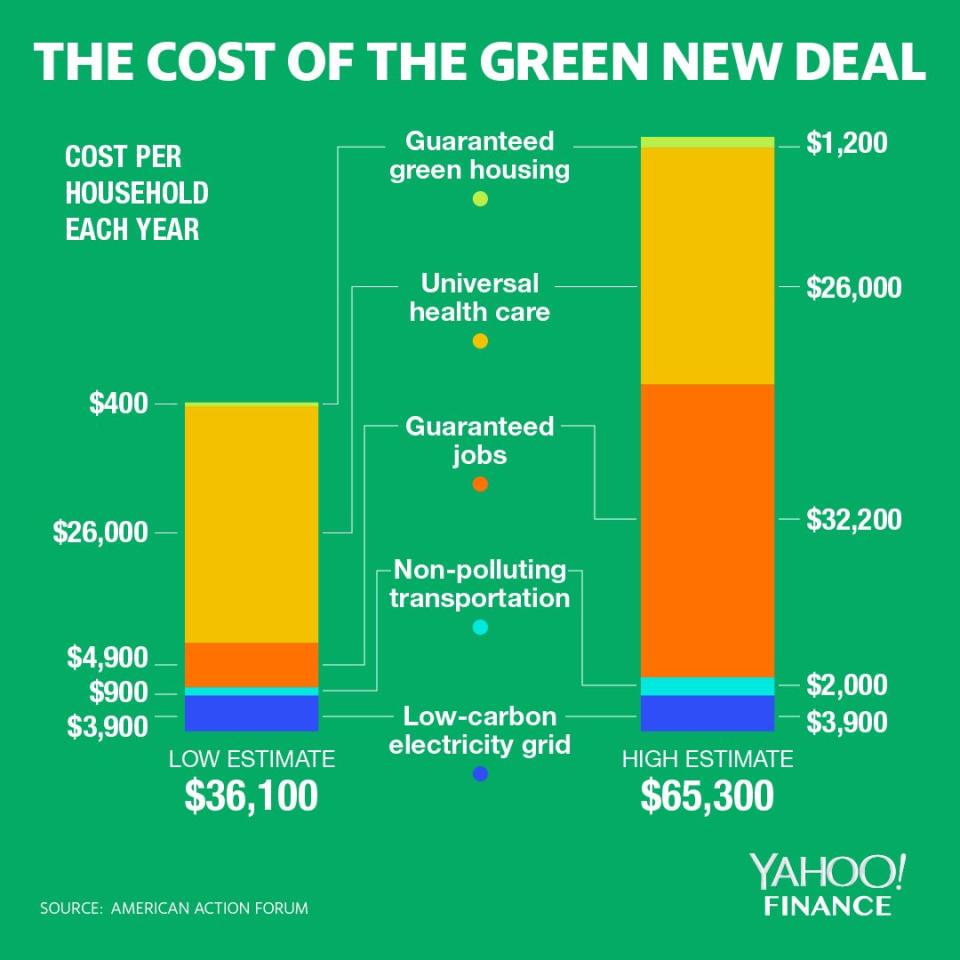Why voters will reject the 'Green New Deal'

Is it OK to bankrupt America to save the planet?
The “Green New Deal” gaining traction among some Democrats would remake much of the US economy in order to slash carbon emissions and address global warming. It would also extend government-run health care to all Americans and expand other social-welfare programs.
The cost, however, would be overwhelming, according to new research. If fully enacted, the Green New Deal would cost the average American household a minimum of $36,000 per year in new taxes, added debt or other economic costs, according to analysis from the center-right American Action Forum. At the high end, the GND could cost every U.S. household $65,000 per year. Even if the costliest elements of the plan were eliminated, the GND would still be so expensive it’s hard to imagine voters signing on, once they know the price tag.
Here’s a breakdown of the costs:

The Green New Deal is a Congressional resolution sponsored by Rep. Alexandria Ocasio-Cortez of New York and Sen. Ed. Markey of Massachusetts. They characterize it not as legislation that could pass anytime soon, but as a vision for what an aggressive plan to fight global warming might look like. Among other things, it would push for the rapid replacement of carbon-based fuel used to power vehicles and airplanes, heat homes and operate factories with sustainable, non-polluting forms of energy. Since there’s not nearly enough wind, solar and other alternative energy sources to replace carbon, the aggressive timetable would require huge technological breakthroughs, funded by the government.
Yet the plan includes many add-ons, such as universal health care, that don’t really have anything to do with environmental protection. And it excludes proven approaches to the problem, such as imposing carbon taxes and rejoining the Paris climate accord, an agreement among most nations to combat global warming in unison, which President Trump withdrew the United States from in 2017.
The Cortez-Markey legislation includes no cost estimates or proposed revenue sources for what would be substantial new government programs. GND supporters argue that such bean-counting misses the point. More important, they say, to launch a grand vision and refine it than to push for incremental changes that might be more pragmatic.
The only problem is that politics doesn’t work that way. While many liberal Democrats support the Green New Deal, many centrist Democrats don’t, because of the cost and disruption it would entail. And Republicans think it’s a juicy opportunity to label Democrats as socialists eager to nationalize vast chunks of the private sector and pay for it with sharply higher taxes.
In reality, the Green New Deal sets up a false choice between the current retrograde policies of the Trump administration—which is rolling back carbon regulations and essentially denying the science of a warming planet—and a utopian solution that assumes an all-powerful government overlord is enlightened and efficient. What GND supporters don’t seem to realize is that others before them have pondered the problem of global warming and come up with some pretty good solutions.
A federal carbon tax, for instance, would raise the cost of petroleum, coal and natural-gas products, creating a powerful incentive for entrepreneurs to develop private-sector alternatives. And it could be phased in over time, to minimize economic disruption while consistently raising the cost of polluting. At least 40 nations have some form of carbon tax, so there’s plenty of real-world analysis on its effectiveness. And instead of requiring new taxes to fund vast government initiatives, a carbon tax would raise revenue. The Treasury Department under President Obama estimated a carbon tax could raise $222 billion per year, while reducing emissions and either funding new programs or allowing Congress to cut other taxes. Yet the Green New Deal doesn’t even mention a carbon tax.
A “cap-and-trade” program would put a legal limit on the amount of emissions allowed each year—which would decline over time—with the government issuing pollution allowances companies can trade in private markets. That would also create powerful market incentives to cut pollution and find alternatives to carbon. Several countries and a few U.S. states have enacted cap-and-trade programs, yet this idea, too, goes unmentioned in the Green New Deal.
If the non-climate elements of the Green New Deal were eliminated, the cost might fall to a range of $4,800 to $5,900 per household per year, according to the American Action Forum numbers. That’s obviously better than $65,000. But any legislation raising costs or taxes faces long odds in Congress, where just a few years back there was a big fight over a law meant to speed the adoption of energy-efficient light bulbs, which cost the average family a few bucks up-front but save money in the long term. A law promising intangible future benefits along with immediate, punishing costs isn’t a vision. It’s a stillbirth.
Confidential tip line: rickjnewman@yahoo.com. Click here to get Rick’s stories by email.
Read more:
Voters are souring on “Medicare for all”
Amazon and the brewing war on corporate America
Trump’s attacks on “socialist” Democrats might just work
3 problems with Elizabeth Warren’s wealth tax
Rick Newman is the author of four books, including “Rebounders: How Winners Pivot from Setback to Success.” Follow him on Twitter: @rickjnewman


